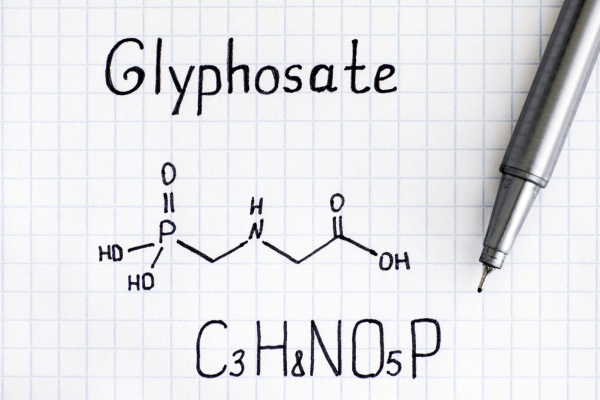Glyphosate, a commonly used herbicide in agriculture for weed control, serves as the primary component in numerous herbicide products. Within the food sector, glyphosate is occasionally utilised as a desiccant for drying crops like wheat and oats pre-harvest. Despite its widespread use, the presence of glyphosate residues in various foods raises awareness regarding potential implications for human health.
Regulatory agencies globally establish limits on glyphosate residues in food as a precautionary measure to guarantee food safety.
This blog gives us an overview of the use of glyphosate in the food industry and how it affects our health with chronic exposure.
What is glyphosate?
N-(phosphonomethyl) glycine, also known as glyphosate, is a broad-spectrum herbicide that enters plants through their foliage and leaves. It was synthesised by a Swiss chemist. It was originally not intended to be used as a herbicide (herbicides: are chemical substances that are mainly used for the killing of unwanted plants like weeds).
Role of glyphosate as herbicide
The main role of glyphosate as a herbicide is to inhibit the enzyme that helps in the synthesis of tryptophan, phenylalanine and tyrosine in plants (they are building blocks of amino acids). It binds to manganese (it is an essential enzyme that helps in the tyrosine, phenylalanine and tryptophan formation pathway). By inhibiting the biosynthetic pathway the growth of the plant is disrupted and leads to death.
It is not toxic to animals because it alters the biosynthesis pathway in plants, and since animals cannot synthesise these necessary amino acids, they must obtain them from the diet. The amount of herbicide applied has dramatically increased as a result of the expansion of glyphosate’s potential applications. Glyphosate is used worldwide.
Use of glyphosate in agriculture
Glyphosate is widely used in the agriculture industry as a herbicide. The highest level of residue glyphosate is found at the time of harvest. The use of glyphosate in genetically modified (GM) crops is more. Studies have found that glyphosate residue was less in organic food.
Residues are found in GM:
- Soybean
- Maize
- Canola
- Fruits
- Vegetables
- Lentils
- Wheat
- Pulses
- Barley
- Oats
Use of glyphosate in processed Foods
Residues can be reduced by processing. Although processed food is expected to have low residue, removing hulls, or portions of foods can increase the concentration of residue. Studies found that there was residue present at detectable levels in many foods including –
- Soy products
- Breakfast cereals
- Infant foods
- Ice cream and sugar
- Honey syrup
- Beer and wine
- Enteral formula
Impact of glyphosate on humans
- Cellular effects – Glyphosate alone did not show any cytotoxicity in humans. In some studies, glyphosate-based herbicides (GBH) dose-dependent toxicity was found. Studies have shown that research only on glyphosate is not enough and more research should be done on GBH. In humans, studies found that exposure to detectable concentrations of GBH lowers the activity of antioxidant enzymes. Reports showed that glyphosate caused mild oxidative stress.
- Reproductive system – The use of glyphosate and GBHs has led to regulation of the oestrogen pathway. It activates the oestrogen receptors in breast cancer cells. One study reported that glyphosate mimics the oestrogen activity. Glyphosate acts as an endocrine disruptor of the oestrogen pathway. There was reduced progesterone production in human placental cells. When exposed in high concentrations it leads to cell death. Pregnant women, when exposed to higher doses of glyphosate, reported multiple miscarriages and preterm births. It also reported there was a link between glyphosate cytotoxicity, and umbilical, embryonic, and placental human cell lines. Studies reported that exposure to glyphosate led to various malformations ranging from cleft lip to Down syndrome.
- Neurological effects – There were some acute neurological alterations found due to the glyphosate being able to pass the brain-blood barrier. Studies conducted in rats found to have:
- Depression and anxiety
- Altered dopamine pathway in chronic exposure.
- Decreased levels of tyrosine hydroxylase enzyme.
- Microbiota dysbiosis of the gut.
- Decreased locomotor activity.
- Digestive system – Ingestion of glyphosate led to slightly altered hepatic progenitor cell lines, this also reduced long-chain and polyunsaturated fatty acid levels. This was found when the concentration was at its lowest. In children, there was no kidney injury found despite residue being found in urine.
- Cardiovascular effects – Numerous effects were found in the cardiovascular system when exposed to GBHs. Studies found that when exposed to acute glyphosate poisoning, the spontaneous spasmodic contractions were inhibited. Individuals also develop heart arrhythmias. In conclusion, glyphosate alone has adverse effects on humans.
- Carcinogenic effects – Studies showed non-significant correlations between GBHs and their carcinogenic effects. Although glyphosate is an analogue of glycine, it inhibits the growth of some cancer cell lines. More research is needed to understand the carcinogenic effects of glyphosate.
- Vitamin deficiency
- Cobalamin deficiency – Glyphosate inhibits the binding of cobalt and hinders the cobalt supply. This leads to a deficiency of cobalt in humans.
- Iron deficiency – Glyphosate and GBHs inhibit the combining of iron in the body leading to anaemia and iron deficiency.
Is it a gluten allergy or a glyphosate allergy?
What is gluten and gluten allergy?
Gluten is a protein found in many cereals such as:
- Wheat
- Rye
- Barley
The main function of gluten is to provide viscosity, cohesivity, elasticity and water absorption. The gluten-rich flours are used in bread making, pasta, meat, ice creams and dressings.
A reaction caused by the immune system to a particular food containing wheat, rye or barley is known as an allergy. Allergy to wheat, rye and barley is different from not tolerating gluten.
Immune system-mediated adverse responses to gluten are known as gluten-related diseases. The gluten related disease is classified into three types
- Celiac disease
- IgE-mediated allergy to wheat.
- Non-celiac gluten sensitivity .
Due to the CYP enzymes involved in retinoic acid breakdown being disrupted by glyphosate, there may be an excess of retinoic acid available in the body, which may worsen celiac disease, damage the liver, and have teratogenic effects on the offspring of exposed persons.
Glyphosate allergy can often be misunderstood as gluten allergy because of the use of glyphosate and GBH herbicides in wheat. Some genetically modified wheat crops too have been exposed to glyphosate and GBHs herbicides.
This exposed wheat crop when consumed causes a dysbiosis between gastrointestinal microbiome and pathogens. This dysbiosis often leads to obesity, reflux disease, inflammation, inflammatory bowel disease, irritable bowel syndrome and cancer. Exposure also affects mental health and individuals often feel depressed and develop anxiety.
Food regulations on use of glyphosate
Food Safety and Standards Authority of India (FSSAI) has restricted the use of glyphosate in rice, tea and meat and meat products to the maximum limit of
- Rice – 0.01mg/kg
- Tea – 1mg/kg
- Meat and meat products – 0.05 mg/kg
The international food standards – The Codex Alimentarius has established the maximum residue limits for glyphosate in various foods. It was first updated in 2006 and for some foods, it was later reviewed in 2021.
In conclusion, glyphosate and GBHs are herbicides that are used in agriculture to kill weeds. These are water-soluble and they contaminate water and soil. Residues are found in many food products but at very low concentrations. Chronic exposure to glyphosate and GBHs has been found to have some adverse effects on health. Glyphosate on ingestion causes some allergic reaction which is often misunderstood as gluten allergy due to glyphosate being used as a herbicide in wheat crops. Governments set some food regulations to maximum residual levels. More research is needed on glyphosate and GBHs and its adverse effects on humans.
Kripa. N,
Senior Clinical Dietitian, Simplyweight





